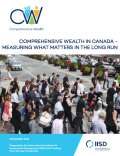
Comprehensive wealth focuses on the role of people, the environment and the economy in creating and sustaining well-being. Complementing indicators like gross domestic product (GDP) and addressing issues the can’t capture on their own, comprehensive wealth measures are key to successfully guiding Canada through the 21st century and beyond.
This study, Comprehensive Wealth in Canada - Measuring what matters in the long run, reviewed Canada’s comprehensive wealth performance over the 33-year period from 1980 to 2013. This timeframe extends well beyond business and political cycles, ensuring that the results reveal trends free from the ebb and flow of markets and policies. The report found that comprehensive wealth grew slowly in Canada between 1980 and 2013 (0.19 per cent annually in real per capita terms). This was in contrast to relatively robust growth in real per capita consumption of goods and services (1.36 per cent annually). The divergence between these two trends points to potential concerns for long-term well-being.
In terms of the components of comprehensive wealth:
This letter analyzes the distributional effects of a carbon tax reform when households must consume carbon-intensive goods above a subsistence level. The reform is progressive if revenues are recycled as uniform lump-sum transfers, in other cases it is regressive.
As the financial and environmental costs of resource depletion and negative ecological impacts begin to affect economic growth, countries around the world need to find ways to manage finite resources while meeting the needs of a growing and increasingly urban world population. By integrating sustainable consumption and production (SCP) patterns into national development planning and implementation, policymakers can make it easier and cheaper to produce goods and services more efficiently, with lower risks to humankind and the environment.
The handbook contains a rich compilation of SCP definitions, case studies from all over the world, policy instruments, policy implementation processes, monitoring and evaluation methodologies and indicators. It also contains compelling data on both the impact of unsustainable consumption and production, and the efficiency gains to be made by mainstreaming SCP patterns.
The ‘attitude–behaviour gap’ or ‘values–action gap’ is where 30% of consumers report that they are very concerned about environmental issues but they are struggling to translate this into purchases. For example, the market share for ethical foods remains at 5 per cent of sales. This paper investigates the purchasing process for green consumers in relation to consumer technology products in the UK. Data were collected from 81 self-declared green consumers through in depth interviews on recent purchases of technology products. A green consumer purchasing model and success criteria for closing the gap between green consumers' values and their behaviour are developed. The paper concludes that incentives and single issue labels (like the current energy rating label) would help consumers concentrate their limited efforts. More fundamentally, ‘being green’ needs time and space in people's lives that is not available in increasingly busy lifestyles. Implications for policy and business are proposed.
